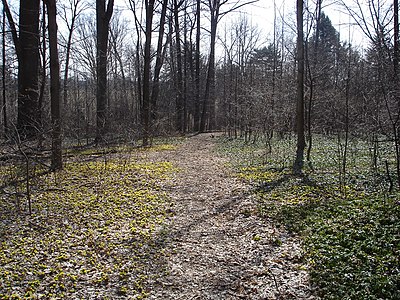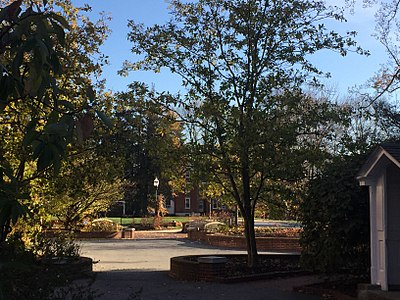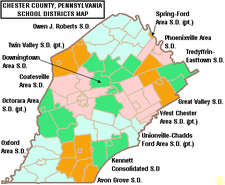Westtown School
This article needs additional citations for verification. (May 2020) |
| Westtown School | |
|---|---|
 | |
| Address | |
 | |
975 Westtown Rd , Pennsylvania 19382 United States | |
| Information | |
| Type | Private |
| Religious affiliation(s) | Quaker |
| Established | May 6, 1799 |
| Interim Head of school | Chris Benbow |
| Faculty | 107 |
| Enrollment | 694 |
| Average class size | 10 students |
| Campus size | 600 acres |
| Color(s) | Brown, White, Blue |
| Athletics | 21 Varsity Teams |
| Mascot | Moose |
| Rival | George School |
| Publication | Westonian |
| Newspaper | Brown and White |
| Yearbook | Amicus |
| Website | www.westtown.edu |
Westtown School is a Quaker, coeducational, college preparatory day and boarding school for students in pre-kindergarten through twelfth grade, located in eastern Pennsylvania.
About Westtown School[]
Founded in 1799 by the Religious Society of Friends,[1] Westtown's campus is located in Chester County, PA, 25 miles west of Philadelphia. In 1799, Westtown was around one day's carriage ride from Philadelphia.
Westtown is a Quaker school affiliated with the Friends General Conference branch of the Religious Society of Friends. All students are required to attend Meeting for Worship together with adults in the community who voluntarily attend (boarding students are required to attend Westtown Monthly Meeting on Sundays as well). Westtown uses the traditional Quaker practice of coming to unity in making some high-level decisions.
Westtown has been a coeducational school since its founding in 1799. Students come from many states and foreign countries.
The 2018 documentary, We Town, is about the 2016-2017 Upper School Basketball Team, featuring Mo Bamba and Cam Reddish. It chronicles the quest of the team to win the State Championship.[2][3]
Currently, students at Westtown come from 16 states and 13 countries.[4]
History[]
Westtown School first opened on May 6, 1799. It was founded by Philadelphia Quakers who raised the money to build a boarding school and purchased land a full day's carriage ride from Philadelphia—where they could provide a “guarded education in a healthy environment" away from the secular influences of the city. For many years, Westtown was nearly self-sufficient, with the campus providing raw materials used in the construction of its buildings and food for the people who lived and worked at the school.
Boys and girls had separate classes until about 1870. Boys learned useful skills such as woodshop, surveying, and bookkeeping, and girls had classes like sewing. However, Westtown eventually recognized that students of both genders should know basic academic subjects such as reading, penmanship, grammar, mathematics, geography, and science.
The 1880s brought physical changes to Westtown. The main building was replaced with a structure designed by architect Addison Hutton, which was completed in 1888 and is still in use today. During the 20th century, the student body and the curriculum both became more diverse. Visual and performing arts were added, for example, and non-Quakers, African-American, and international students were eventually admitted.
Westtown's Esther Duke Archives is a facility dedicated to collecting and maintaining materials relating to the people and history of the school. Students and historians alike use the Archives for historical research.
Westtown's Campus[]
Westtown is located on a campus in southern Pennsylvania. The campus is 600 acres, including a 14.5-acre lake, arboretum, frog pond, 14 playing fields, stadium tennis courts, organic farm, Lower School mini-farm, medicine wheel garden, wooded cross country course, and 21-element ropes course.[5]
Notable alumni[]
- Samuel Leeds Allen (May 5, 1841 – March 28, 1918), inventor of the Flexible Flyer, the world's first steerable runner sled
- Mohamed Bamba, Class of 2017, basketball player for the Orlando Magic
- Anna Cox Brinton (1887–1969), classics scholar, Quaker worker overseas, administrator at Pendle Hill
- John Cassin, ornithologist
- Marysol Castro (b. September 29, 1976), weather anchor for ABC's Good Morning America Weekend Edition
- Laetitia Moon Conard (1871–1946), college instructor and politician in Iowa
- Steve Curwood, Class of 1965, is host of NPR's Living on Earth environmental news series
- Jim Fowler (1930-2019), Class of 1947, Conservationist and wildlife correspondent/show host - Mutual of Omaha's Wild Kingdom
- Benjamin Hallowell, president of Maryland Agricultural College
- Arthur W. Hummel, Jr. Class of 1938, American diplomat; U.S. ambassador to China, 1981-1985
- Richard T. James (1914–1974), with his wife, invented the Slinky
- Rebecca Lukens (1794-1854) Considered first woman industrialist in the United States.[6]
- Edward Mifflin, Class of 1941, Pennsylvania State Representative
- Herb Pennock, Class of 1915, Major League Baseball player and manager, baseball Hall of Fame
- Cameron Reddish, Class of 2018, basketball player for the Atlanta Hawks
- Kevin Roose, technology columnist for the New York Times
- Holland Taylor (born January 14, 1943), Emmy Award-winning American actress
- Garrick Utley, Class of 1957, correspondent for CNN’s New York bureau
- Don Wildman, Class of 1979, the current host and narrator of Cities of the Underworld on History
- Anthony H. Williams, Class of 1975, Pennsylvania State Senator, 8th District
Photo gallery[]

The Westtown campus is surrounded by several acres of woods.

Campus trees.

Geese flying over Main Hall.

Main building

Athletics building

Middle school playground
References[]
- ^ "Westtown School: Our Mission, Values, & Philosophy". www.westtown.edu. Retrieved 2020-02-04.
- ^ WeTown, retrieved 2020-02-04
- ^ Haughton, Dania. "Meet the starting five featured in SI TV's 'We Town'". Sports Illustrated. Retrieved 2020-02-04.
- ^ "Westtown School: Private co-ed Quaker Day & Boarding School". www.westtown.edu. Retrieved 2020-02-04.
- ^ "Westtown School: Our 600 Acres". www.westtown.edu. Retrieved 2020-02-04.
- ^ https://www.smithsonianmag.com/blogs/national-museum-american-history/2021/08/06/rebecca-lukens/?utm_source=facebook.com&utm_medium=socialmedia&fbclid=IwAR1QZggAjt3UeKG3kOX8Eu95c9SDuEXVXfZFjdDBmSzKObIxL7l3r5OZd1g
External links[]
- Boarding schools in Pennsylvania
- Private elementary schools in Pennsylvania
- Private middle schools in Pennsylvania
- Private high schools in Pennsylvania
- Educational institutions established in 1799
- 1799 establishments in Pennsylvania
- Quaker schools in Pennsylvania
- Schools in Chester County, Pennsylvania
- Private high schools in the United States
- High school basketball
- Basketball teams in Pennsylvania
- Quaker schools







